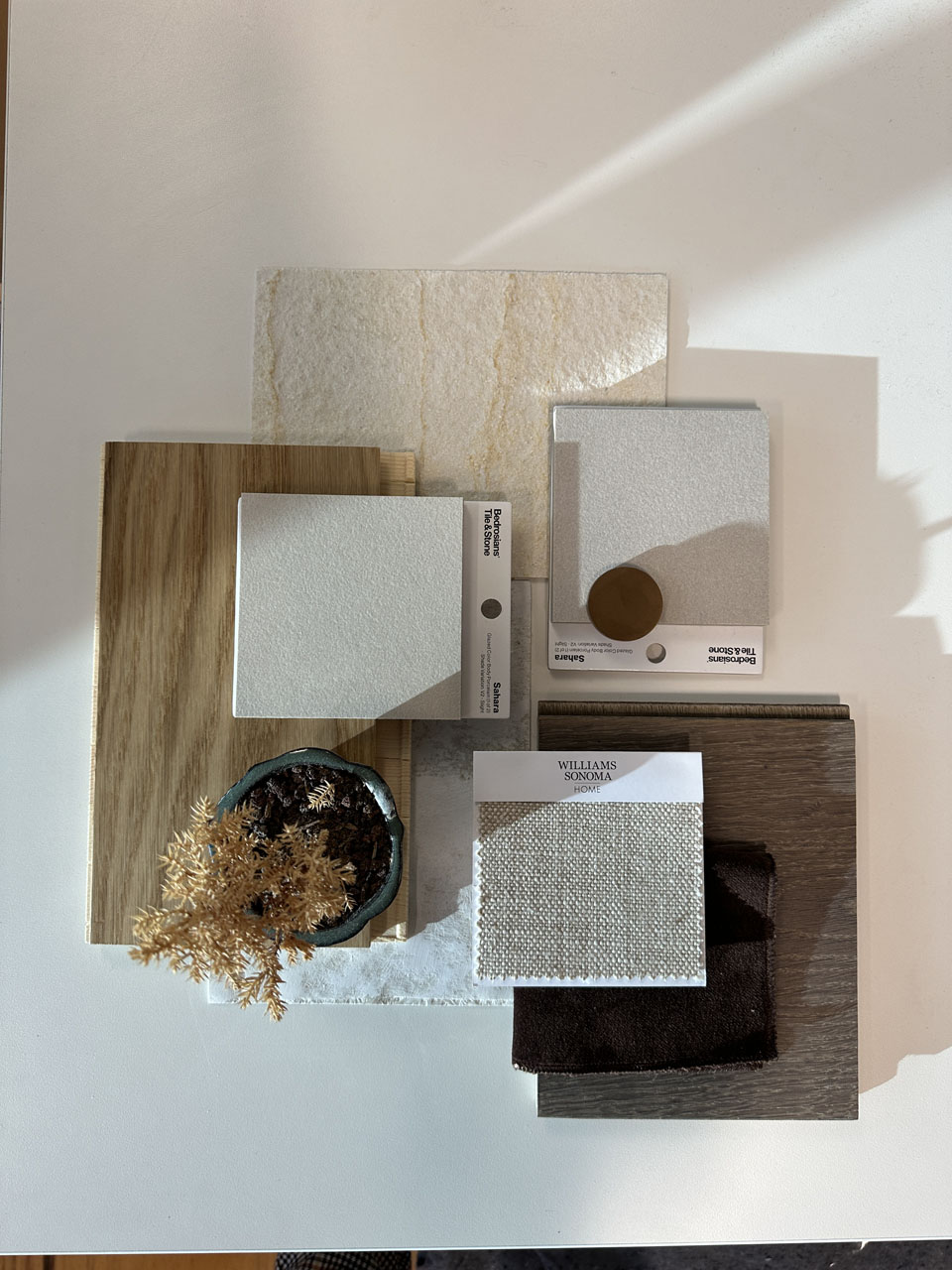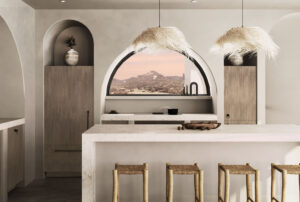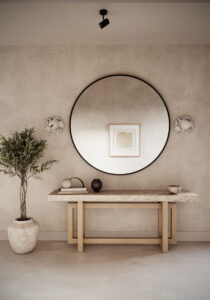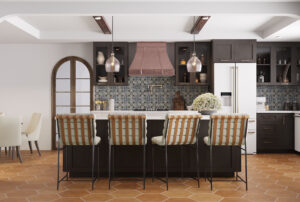What is modern interior design? It is a testament to the harmonious blend of form and function, using clean lines, neutral palettes, and a decluttered approach to create spaces that are both welcoming and aesthetically pleasing. This article cuts through the ambiguity to explore the essence, evolution, and core principles of modern design and how they can be applied in today’s homes.
Key Takeaways
- Modern interior design is a timeless and functional philosophy emphasizing simplicity, clean lines, and the use of natural materials, striving to create serene, decluttered environments that are both visually appealing and practical.
- Modern design is distinct from contemporary design, despite shared values such as minimalism and open floor plans; modern design draws from historical modernist movements while contemporary design incorporates a more fluid, evolving range of styles.
- The success of modern design relies on the careful selection of high-quality, functional furniture and decor, strategic use of neutral color palettes with textures and bold accents, and conscious spatial arrangements that optimize the experience within the space.
The Essence of Modern Interior Design
Modern interior design is not merely a trend; it’s a reflection of the modern art movement, a statement of living that celebrates simplicity, functionality, and the beauty of natural materials. It’s a design philosophy that resonates with those who seek to declutter their lives and their spaces, finding serenity in monochromatic color schemes, clean lines, and uncluttered environments. At its core, modern design is about crafting spaces that are as functional as they are visually appealing, offering a retreat from the complexities of daily life.
Our commitment to modern style is evident in our work, which often features sleek furniture, neutral palettes, and an abundance of natural light, fulfilling the desire for minimalist aesthetics and organized spaces. This design style approach provides a canvas for personal expression while maintaining the timeless allure that modernism is known for. It’s a style that appeals to those who value precision, quality, and a connection with the environment around them.
The History and Evolution of Modern Style
The journey of mid century modern design began in the early 20th century, amid a burgeoning modernist movement that sought to redefine art and architecture. This period marked a departure from the ornate and decorative styles of the past, paving the way for a new era of simplicity and functionality. Visionaries like Le Corbusier and the dynamic duo of Charles and Ray Eames became the torchbearers of this movement, creating furniture and spaces that embodied the essence of modern style.
Influential schools, such as the German Bauhaus and the proponents of Scandinavian design, further shaped the contours of modern design. They instilled principles that emphasized the harmony between form and function, elements that continue to be celebrated in today’s interior design landscape. These movements not only influenced the aesthetic of the time but also laid the groundwork for the contemporary appreciation of modern design.
Key Characteristics of Modern Spaces
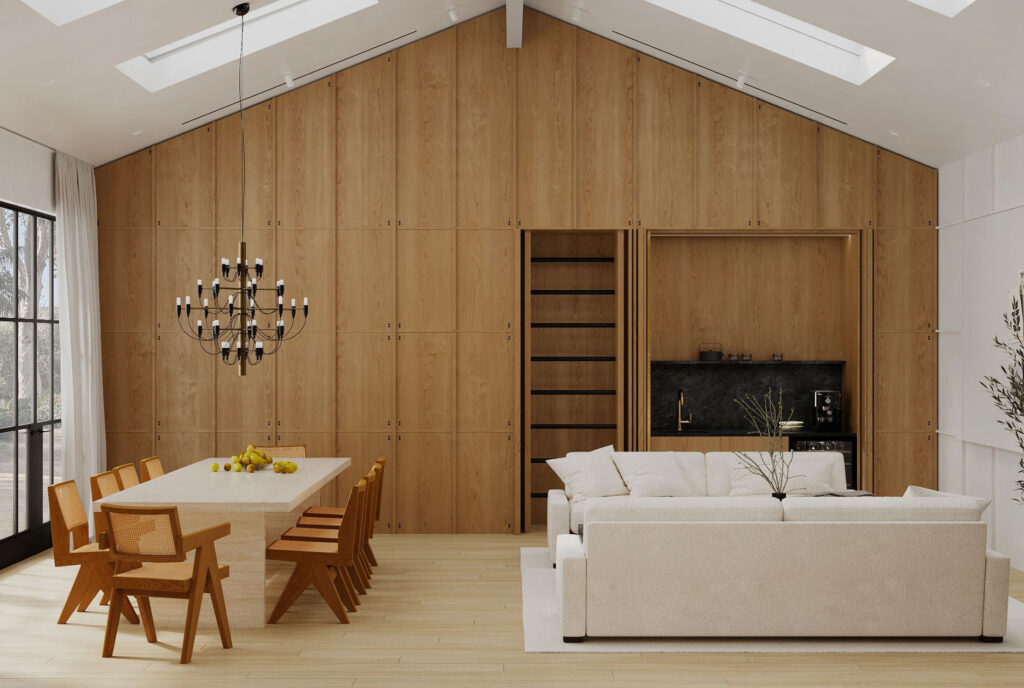
The hallmark of modern spaces is the elegance of simplicity, where clean lines and uncluttered surfaces converge to create a sense of calm and comfort. These spaces are thoughtfully designed to promote harmony and unity, often achieved through the use of straight lines, an open floor plan that fosters cohesiveness and a seamless flow between areas, the integration of environmentally-friendly features, and the use of new materials that reflect a growing trend towards sustainability and innovation.
As we draw inspiration from the modern art movement, our designs incorporate:
- A neutral color palette that serves as a backdrop to the natural light filling the space
- An interplay of light and shade
- Crisp lines
- The warmth of natural materials like wood and stone
These elements add depth and texture to our modern homes, inviting tranquility into everyday living.
Modern Elements in Practice
At Anna Design, we often employ open floor plans to create a seamless transition between living, dining, and kitchen areas. This concept of spatial fluidity, coupled with large windows or sliding glass doors, invites ample natural light and establishes a connection with the outdoors. To maintain an organized environment, we integrate functional storage solutions like built-in closets and multi-functional furniture, ensuring that every item has its place.
While our neutral color palettes serve as a versatile backdrop, we also embrace the strategic use of color accents and geometric patterns to add depth and visual interest without compromising the minimalist aesthetic. Natural materials and statement pieces, such as dramatic light fixtures or bold artwork, are thoughtfully placed to act as focal points, adding individuality to a modern interior. Moreover, textures are utilized to prevent the space from appearing flat, ensuring richness and depth across all surfaces.
Modern vs Contemporary: Clarifying the Confusion

Navigating the nuances between modern and contemporary design can be akin to deciphering a complex code. Modern design, with its historical significance and functional emphasis, exudes a warmth that is rooted in the use of natural colors and materials. Contemporary design, on the other hand, is characterized by its fluidity and adaptability, blending elements from a variety of styles, including modernism and Art Deco, to reflect the zeitgeist of the present.
While modern design celebrates the design movements of the past, contemporary design refers to an ever-evolving style, mirroring the current trends and often borrowing from multiple styles such as futurism and deconstructivism. Both, however, share a love for simplicity and clean lines, though contemporary design sets itself apart with organic silhouettes and a palette that may feature a range of materials from nickel to jute.
The Intersection of Modern and Contemporary Design
The intersection of modern and contemporary design is marked by a shared appreciation for open floor plans and the abundant use of natural light, which are central to both aesthetics. The seamless transitions between different areas, a principle cherished in both styles, help maintain aesthetic continuity and create spaces that are both functional and visually appealing. It’s the blend of these shared values that allows for the creation of contemporary interior design spaces that are unique and personalized, reflecting the homeowner’s character. By exploring various contemporary interior design styles, homeowners can find the perfect balance between modern and contemporary design elements to create their ideal living space.
Neutral color palettes serve as a versatile canvas, creating a balance conducive to both modern and contemporary designs. This adaptability allows for the incorporation of bold accents or a mix of traditional and modern elements, offering endless possibilities for personalization. Whether one leans towards the timeless appeal of modern design or the dynamic nature of contemporary style, the intersection of these two philosophies can yield a space that resonates with individual tastes and lifestyles.
When to Opt for Modern Over Contemporary
Choosing between modern and contemporary design often comes down to architectural features and personal preferences. When considering contemporary vs modern design, it’s important to note that modern design may be more fitting for homes that boast mid-century modern elements or structures built during the modernist era, where the aesthetic aligns naturally with the architecture. Clients who favor the clean lines and uncluttered look characteristic of the mid-20th century might find themselves gravitating towards modern rather than contemporary design.
Lifestyle factors also play a significant role in this decision-making process. A preference for open and functional spaces, often adorned with iconic mid-century modern furniture, may tip the scales in favor of modern design. Moreover, when a client’s aesthetic leans towards the timeless qualities of modern design, with a penchant for functionality and a restrained palette accented by bold statement pieces, modern design becomes the natural choice.
Modern Design Elements and How to Use Them
Identifying and utilizing the right design elements is crucial for achieving the polished look and feel of modern design. From selecting the perfect piece of furniture to choosing the right color scheme, each decision plays a pivotal role in the overall aesthetic. In the following sections, we’ll explore how to select furniture and decor, create harmonious color schemes, and arrange lighting and space to create a modern masterpiece.
Modern design elements are the building blocks of a contemporary room that exudes elegance. These elements, when used thoughtfully, create an environment that is both aesthetically pleasing and functional. With a focus on furniture, colors, and lighting, we can transform an ordinary room into a modern haven that reflects the latest interior design trends while maintaining a timeless appeal.
Furniture and Decor Selections
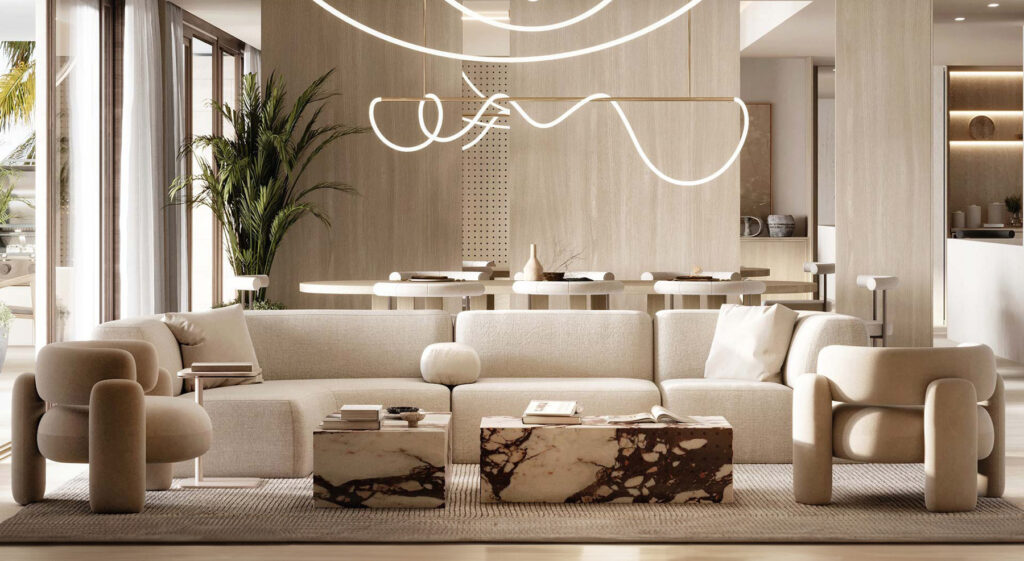
In modern design, selecting furniture and decor is as much about functionality as it is about style. A minimalist approach is key, favoring furniture that serves a purpose while steering clear of unnecessary embellishments. Investing in fewer, high-quality furniture pieces aligns with the modern interior’s value of quality over quantity, ensuring that each item within the space holds its own significance.
Artwork plays a pivotal role in modern interiors, often serving as the centerpiece that defines the room’s ambiance and reflects the homeowner’s personality. Curated and strategically arranged furniture and decor create serene and harmonious spaces, reinforcing the design’s intent and showcasing personal style.
Iconic pieces, like Mies van der Rohe’s Barcelona chair, are frequently chosen for their historical significance and timeless appeal, complementing the clean lines and restrained decoration style that are preferred in modern design.
Color Schemes and Textures

Neutral color palettes are the cornerstone of modern design, laying the foundation for a serene and cohesive atmosphere. These palettes extend beyond the traditional beige, embracing a spectrum of hues from the crispness of white to the soft warmth of taupe, and even gentle pastels like soft blues and blush pinks. The neutrality of the walls serves as a clean canvas, compatible with a variety of design elements and allowing for versatility in decor choices.
Textures play a crucial role in setting the ambiance of modern spaces. They come in a wide range, from soft and inviting textiles to hard and edgy industrial elements, creating a multisensory experience that is both visually and tactilely engaging. By incorporating natural materials like wood and stone, we add depth and an organic appeal that complements the neutral color schemes, balancing warm and cool tones for a rich, layered look.
Bold primary colors, drawn from movements like Bauhaus and De Stijl, can also make a significant impact, adding vibrancy and contrast to the otherwise neutral backdrop.
Lighting and Spatial Arrangement
Lighting in modern design is not just about illumination; it’s about enhancing the spatial qualities of the room. Emphasizing natural light is paramount, with large windows creating bright, airy spaces that feel like extensions of the outdoors. When artificial lighting is used, it should be simple and unobtrusive, complementing the minimalist aesthetic while providing a warm ambiance.
The spatial arrangement is a deliberate and strategic component of modern interiors, designed to optimize the experience within the space. Some key elements of modern interior design include:
- Radial balance, achieved by arranging furniture around a central item, guides the flow and focus of the room.
- Dynamic ceiling treatments can manipulate perceptions of space, adding depth and interest.
- Biophilic elements, such as plants and strategic window treatments, enhance air quality and personal well-being.
These design choices make the modern space not only aesthetically pleasing but also healthful.
Open-plan layouts encourage unobstructed airflow and a sense of spaciousness, integral to the modern lifestyle.
Anna Design’s Approach to Modern Interior Design
At Anna Design, we believe that modern interior design is more than just a collection of design elements; it’s about creating spaces that resonate with the individuals who inhabit them. Our approach is deeply personalized and art-centric, focusing on high-quality materials and craftsmanship to preserve the spirit of the home. Each project, from Pacific Palisades to Vista, Los Angeles, is a testament to our mission to bring clients’ dream homes into reality by understanding their vision and meticulously guiding them through the entire design process.
Our signature style is evident in the elegant materials we choose, such as marble and wood, which contribute both to the functionality and the aesthetic appeal of the spaces we curate. We take pride in tailoring our designs to meet the specific needs, preferences, and personal styles of our clients, ensuring that every space we design is as unique as the individuals who live there.
Infusing Spirit into Modern Homes
Anna Vasiltsova, the visionary behind Anna Design, believes that the spirit of a home is integral to its design. A home should be a reflection of the homeowner’s character, an embodiment of their life’s narrative that extends beyond mere walls and furniture. Each space we craft is deeply personal, capturing the essence of the homeowner while preserving the inherent style and soul of the structure itself, whether it’s a renovation project or a new design.
Our commitment to creating interiors that enhance the daily lives of our clients is inspired by Anna’s diverse living experiences. This global perspective allows us to design spaces that are not only visually stunning but also functional and comfortable, enhancing the quality of life for those who dwell within. The meticulous attention to detail and passion for delivering exceptional results is what sets Anna Design apart, ensuring that each project is imbued with spirit and quality.
The Role of Team Expertise
The success of Anna Design in creating stunning modern interiors is also attributed to the collective expertise of our team members. Olga Sorokoletova, as the Purchasing Manager and Stylist, brings her keen sense of functional beauty to every project, selecting pieces that not only look exquisite but also serve a purpose within the space. Lada Kovalkova leverages her passion for design and her technical drafting skills to add both artistic flair and precision to our projects.
Max Babyn’s expertise in interior design and architecture ensures that our spaces are not just visually appealing but highly functional, meeting the needs of modern living. The seamless operations and meticulous planning behind each project are the domain of Kayla Luster, our office manager, who ensures that from the initial concept to the final touches, every aspect of the design process runs smoothly. Together, the team at Anna Design embodies a synergy of artistry and technical prowess, resulting in spaces that are both beautiful and livable.
Incorporating Modern Design in Different Home Environments
Modern design is versatile and adaptable, capable of enhancing a variety of home environments. By incorporating earth tones and organic shapes, we can create spaces that harmonize with nature, bringing the calmness of the outdoors inside. Elemental features such as tabletop fountains and fireplaces add a sense of tranquility and warmth, making modern spaces more inviting. Biophilic design elements, including cozy nooks and biomorphic forms, nurture well-being, while mismatched furniture mirrors the randomness found in nature, seamlessly blending modern aesthetics with organic interior design.
Anna Design’s expertise in adapting modern design to different settings is showcased in our diverse project portfolio. We have crafted high-end modern interiors across greater Los Angeles, from the breezy coastal retreats in Santa Monica to the sophisticated urban lofts in Manhattan Beach. Our ability to tailor modern design to various environments demonstrates the studio’s creative versatility and our commitment to delivering personalized spaces that reflect the unique character of each client.
Summary
As we journey through the world of modern interior design, it becomes clear that this distinct style is more than a mere aesthetic choice; it’s a lifestyle statement that embraces minimalism, functionality, and the essence of modern art. From the historical roots of modernism to the practical application of its principles, and from the nuances that differentiate it from contemporary design to the personalized approach by Anna Design, we’ve explored the rich tapestry that makes modern interior design a timeless choice for homeowners. Let this exploration inspire you to envision spaces that not only look magnificent but also resonate deeply with your way of life, creating sanctuaries of peace and beauty.
Frequently Asked Questions
What distinguishes modern design from contemporary design?
Modern design is defined by historical influences like the Bauhaus and mid-century modern movements, with clean lines and natural materials, while contemporary design evolves with current trends and incorporates a mix of styles.
How does Anna Design create spaces that reflect the homeowner’s character?
Anna Design creates spaces that reflect the homeowner’s character by employing a highly personalized approach, collaborating closely with clients to understand their vision, lifestyle, and personal style, ensuring that the resulting space is a unique reflection of their character and enhances their daily lives.
Can modern design elements be integrated into any home environment?
Yes, modern design can be integrated into various home environments through the use of adaptable elements such as earth tones, organic shapes, and biophilic elements, as done by Anna Design.
What role do lighting and spatial arrangement play in modern design?
In modern design, lighting and spatial arrangement play a crucial role. They prioritize natural lighting for bright, open spaces and strategically optimize spatial arrangement to enhance flow and functionality.
What are some iconic furniture pieces used in modern design?
Iconic furniture pieces used in modern design include classics like Mies van der Rohe’s Barcelona chair, known for their historical significance and timeless design, which perfectly complement the minimalist and functional aesthetic of modern interiors.
